
Main
Accoucheur's
Antique
7xCoke
Home
Medical Antique Collection

| Majority of births, (98 %) were normal. The normal birth of a living child was the realm of the midwife. A few deliveries were difficult or obstructed. Problem labor were subdivided into obstructed and complicated deliveries. Obstructed labor was subcategorized as head, breech, and arm presentations. The head obstruction was the most common source of difficulty with an incidence of 6 to 12 per 1000. The 3 major complicated labor were: "Flooding" (hemorrhage), "Fits" (eclampsia), and "Puerperal fever". When the midwife has problems with obstructed labor or complicated labor, often times the baby is already dead, she summons a man midwife. During the 17th Century, male midwives only attended childbirth as a complement to the midwife. The man midwife carries with him a set of instruments to hasten the delivery of a child. |
|
CASED ENGLISH OBSTETRICAL SET |
 |
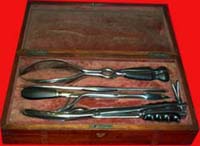 |
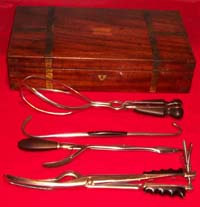 |
|
Circa 1840s |
 |
|
 |
|
 |
|
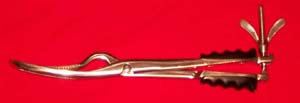 |
Braun's
Cranioclast
Powerful
destructive craniotomy forceps. The smaller blade is introduced
to the perforated skull, the larger blade is placed to the outer
surface of the skull. The blades are locked and the fetus is extracted
out. |
|
LARGE OBSTETRICAL SET IN MAHOGANY CASE |
 |
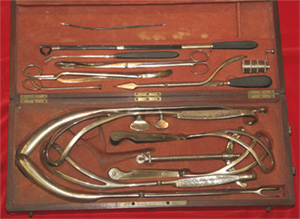 |
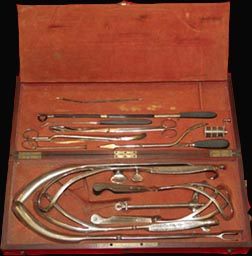 |
| Large
English Obstetrical Set Mahogany case with red velvet lining. Marked Charriere Collin, Paris. Circa 1850s |
 |
Blots Arrow Peforator |
 |
Butler's Scarificator |
 |
Cleidotomy
Scissors Large scissors used to decapitate
fetal head, divide collar bones of the fetus on obstructed labor.
Dividing the collar bones allowed the shoulders to collapse and thus
allow delivery.
|
 |
Embryotomy
forceps Fig 3795, p550 Tiemann |
 |
OB
Forceps Ebony handle with upturned knob in the end. Unplated steel. |
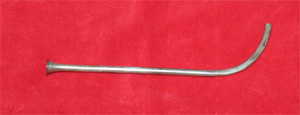 |
Robin's
Insufflator Inserted inside the fetus' endotracheal tube for resuscitation. Fig 3794 pg 548 Tiemann. |
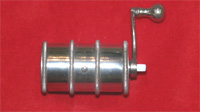 |
|
 |
Scholler's
Cord Carrier Insturment for holding or changing the postion of the umbilical cord. Used to reduce the umbilical cord in cord prolapse. Fig 3789 pg 584 Tiemann. |
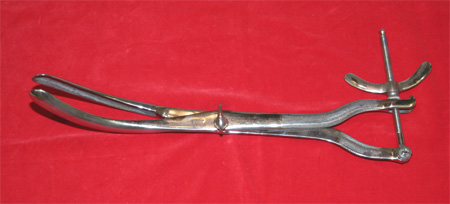 |
Simpson's
Cephalotribe Heavy unplated steel with French lock. Fig 3821 pg 552 |
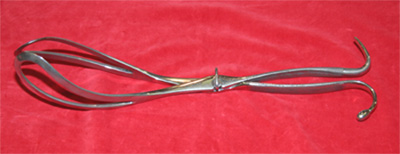 |
Dubois OB Forceps Blunt and crochet end of handle. |
 |
Bistoury Used to cut pubic bone joint (Pubiotomy) |
|
GYNECOLOGY SET ON A LEATHER BAG |
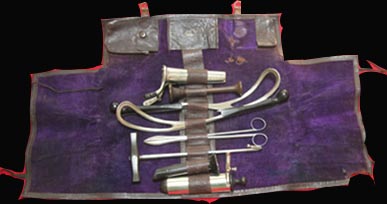 |
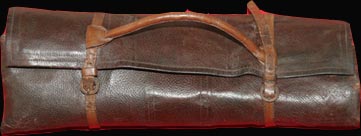 |
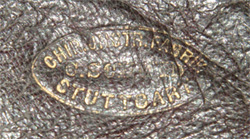 |
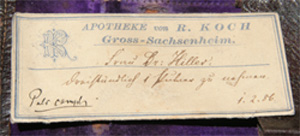 |
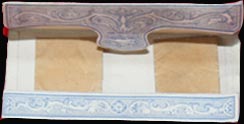 |
|
1886
Gynecology Instrument Set
A
rare complete set of gynecology instrument dated 1886 by Schmid
Stuttgard in its original velvet lined leather bag. It consists of a
bakelite monaural stethoscope,
an ebony and ivory Braun's decollator, a
Simpson's perforator and rubber hadled obstetric foceps. Also three
rare vaginal specula: Ricord's bivalve, Ferguson's, and Segala
tri-valve.
There is
an original folded chemist's prescription by Dr Hiller, dated February
1, 1886 with two sachets containing their original powdered camphor (often laced with
opium). |
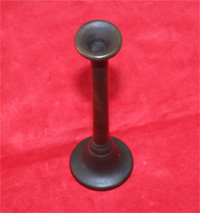 |
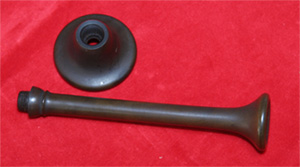 |
Monaural
Stethoscope Two-piece bakelite monaural stethoscope. |
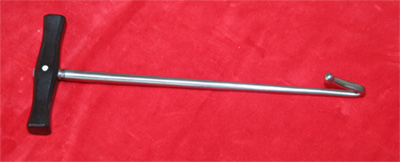 |
Braun's
Decollator
Ebony- ivory handled destructive
obstetric instrument. Decapitation was accomplished by
introducing the blunt hook around the fetal head.
|
|
 |
Simpson's
Perforator Unplated
steel. Signed: Wickert Munchen.
|
|
 |
OB Forceps Rubber
handle with
English lock and
upturned knob at the end . Signed:
Wickert Munchen.
|
|
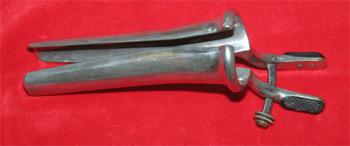 |
Ricord's Bivalve Vaginal Speculum | |
 |
Ferguson
Speculum With internal mirror finish. |
|
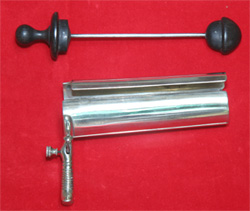 |
 |
Segala
Tri-valve Speculum Tri-valve
speculum with ebony introducer.
Signed: Charriere. |
|
with Obstetrical Instruments by Sharp and Smith, dated 1880. Illustrated on Keith Wilbur,
M.D. 3rd Edition,
1998 |
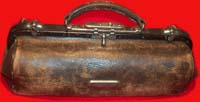 |
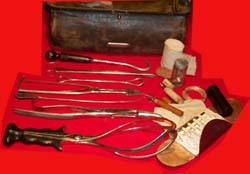 |
 |
|
 |
|
 |
Fig 3252, Tiemann. |
 |
|
|
|
|
 |
|
 |
|
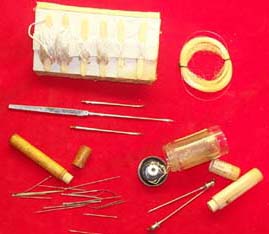 |
Included in the obstetrical bag are needles of varying sizes in tube containers and spools of silk sutures of different sizes to repair perineal laceration and episiotomy incisions after delivery. |
|
Circa 1820's |
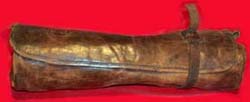 |
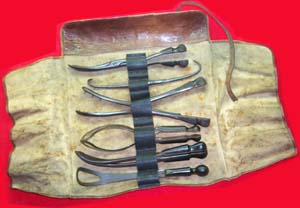 |
 |
|
| Conquet's Cranioclast | Crochet and Hook |
 |
 |
| Holmes' Cranioclast | Hamilton Forceps |
 |
 |
| Cranioclast with English lock | Hinged Vectis |
|
Circa 1870 by Henry Lewis |
 |
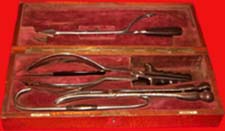 |
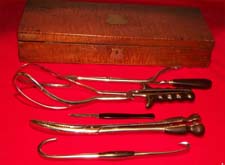 |
 |
Fig 3804, Tiemann |
 |
Fig. 3782, Tiemann |
 |
Fig. 3817, Tiemann |
 |
|
 |
Blunt Hook and Crochet |
|
Circa 1875 |
 |
 |
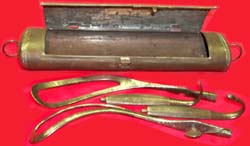 |
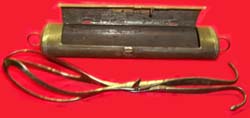 |
|
|
 |
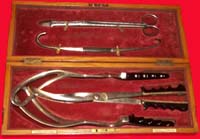 |
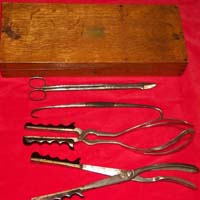 |
|
Small Cased OB Set
Wood
cased obstetrical set. Four ob tools in red velvet lining in
fitted interior. From left
to right: Hook and crochet, Naegele's perforator, ob forceps, hinged vectis.
Signed:
Evans
|
 |
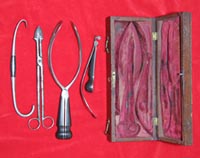 |
|
OB Set on Canvas Case Set of six obstetrical nickel plated instruments on a canvas case. From top to bottom: Simpson's spring loaded perforator, Blunt hook and crochet, Uterine irrigator, Embryotomy forceps with French lock, OB forceps with finger ring, and Simpson cranioclast. Signed: Arnold & Sons, London. |
 |
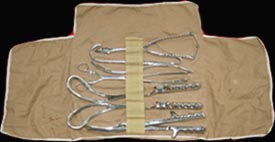 |
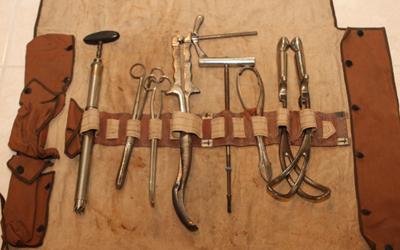 |
German
Roll of Obstetrical Instruments:
Circa, Late 19th Century.
From left to right: Leisnisch
Kiewisch trephine instrument, Boer's spiked cranioclast, placenta
forceps, Kehrer's cranioclast, blunt hook forceps, perforator,
obstetrical forceps.All signed Holzhauer except the placenta forceps which are signed Gruewald. |
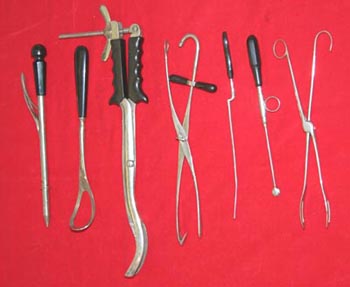 |
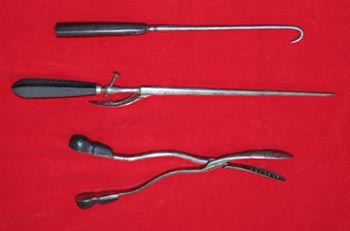 |
|
OB
Set of 7
From
left to right: Thomas perforator, vectis, cephalotribe, guarded hook and
crochet with butterfly handle, folding uterine
sound, uterine
repositor, and embryotomy
forceps. All
signed: Tiemann. |
OB
Set of 3
From top to bottom: OB hook,
Basilyst
perforator, Conquest craniotomy forceps. |
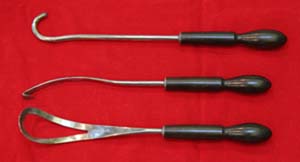 |
Destructive
OB Set of 3 Blunt hook, crochet, and a vectis. |
All statements in
this web page
regarding date, age, and origin are statements of opinion. All
photos
and materials on this web page are protected by copyright laws.
Please
obtain direct permission from to
use any and all materials on this site, including photographs and
drawings.
to
use any and all materials on this site, including photographs and
drawings.